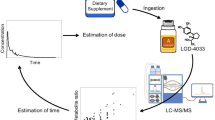Abstract
A family of small peptides has reached the focus of doping controls representing a comparably new strategy for cheating sportsmen. These growth hormone releasing peptides (GHRP) are orally active and induce an increased production of endogenous growth hormone (GH). While the established test for exogenous GH fails, the misuse of these prohibited substances remains unrecognized. The present study provides data for the efficient extraction of a variety of known drug candidates (GHRP-1, GHRP-2, GHRP-4, GHRP-5, GHRP-6, alexamorelin, ipamorelin, and hexarelin) from human urine with subsequent mass spectrometric detection after liquid chromatographic separation. The used method potentially enables the retrospective evaluation of the acquired data for unknown metabolites by means of a non-targeted approach with high-resolution/high-accuracy full-scan mass spectrometry with additional higher collision energy dissociation experiments. This is of great importance due to the currently unknown metabolism of most of the targets and, thus, the method is focused on the intact peptidic drugs. Only the already characterised major metabolite of GHRP-2 (d-Ala-d-2-naphthylAla-l-Ala, as well as its stable isotope-labelled analogue) was synthesised and implemented in the detection assay. Method validation for qualitative purpose was performed with respect to specificity, precision (<20%), intermediate precision (<20%), recovery (47–95%), limit of detection (0.2–1 ng/mL), linearity, ion suppression and stability. Two stable isotope-labelled internal standards were used (deuterium-labelled GHRP-4 and GHRP-2 metabolite). The proof-of-principle was obtained by the analysis of excretion study urine samples obtained from a single oral administration of 10 mg of GHRP-2. Here, the known metabolite was detectable over 20 h after administration while the intact drug was not observed.




Similar content being viewed by others
References
Camanni F, Ghigo E, Arvat E (1998) Growth hormone-releasing peptides and their analogs. Front Neuroendocrinol 19:47–72
Ghigo E, Arvat E, Muccioli G, Camanni F (1997) Growth hormone-releasing peptides. Eur J Endocrinol 136:445–460
Okano M, Sato M, Ikekita A, Kageyama S (2010) Determination of growth hormone secretagogue pralmorelin (GHRP-2) and its metabolite in human urine by liquid chromatography/electrospray ionization tandem mass spectrometry. Rapid Commun Mass Spectrom 24:2046–2056
Thevis M, Schänzer W (2007) Emerging drugs—potential for misuse in sport and doping control detection strategies. Mini Rev Med Chem 7:531–537
Thomas A, Kohler M, Mester J, Geyer H, Schänzer W, Petrou M, Thevis M (2010) Identification of the growth-hormone-releasing peptide-2 (GHRP-2) in a nutritional supplement. Drug Test Anal 2:144–148
Bidlingmaier M, Suhr J, Ernst A, Wu Z, Keller A, Strasburger CJ, Bergmann A (2009) High-sensitivity chemiluminescence immunoassays for detection of growth hormone doping in sports. Clin Chem 55:445–453
Bidlingmaier M, Manolopoulou J (2010) Detecting growth hormone abuse in athletes. Endocrinol Metab Clin North Am 39:25–32, vii
Okano M, Nishitani Y, Sato M, Ikekita A, Kageyama S (2010) Influence of intravenous administration of growth hormone releasing peptide-2 (GHRP-2) on detection of growth hormone doping: growth hormone isoform profiles in Japanese male subjects. Drug Test Anal. doi:10.1002/dta.166
Hartman ML, Farello G, Pezzoli SS, Thorner MO (1992) Oral administration of growth hormone (GH)-releasing peptide stimulates GH secretion in normal men. J Clin Endocrinol Metab 74:1378–1384
Hashizume T, Tanabe Y, Ohtsuki K, Mori A, Matsumoto N, Hara S (2001) Plasma growth hormone (GH) responses after administration of the peptidergic GH secretagogue KP102 into the oral cavity, rumen, abomasum and duodenum in adult goats. Domest Anim Endocrinol 20:37–46
Bowers CY, Alster DK, Frentz JM (1992) The growth hormone-releasing activity of a synthetic hexapeptide in normal men and short statured children after oral administration. J Clin Endocrinol Metab 74:292–298
Mericq V, Cassorla F, Bowers CY, Avila A, Gonen B, Merriam GR (2003) Changes in appetite and body weight in response to long-term oral administration of the ghrelin agonist GHRP-2 in growth hormone deficient children. J Pediatr Endocrinol Metab 16:981–985
http://www.wada-ama.org/Documents/World_Anti-Doping_Program/WADP-Prohibited-list/To_be_effective/WADA_Prohibited_List_2011_EN.pdf, assessed Jan 2011.
Asakura Y, Toyota Y, Muroya K, Adachi M (2010) Growth hormone response to GH-releasing peptide-2 in children. J Pediatr Endocrinol Metab 23:473–480
Werle M, Bernkop-Schnurch A (2006) Strategies to improve plasma half life time of peptide and protein drugs. Amino Acids 30:351–367
Thomas A, Guddat S, Kohler M, Krug O, Schänzer W, Petrou M, Thevis M (2010) Comprehensive plasma-screening for known and unknown substances in doping controls. Rapid Commun Mass Spectrom 24:1124–1132
Peters RJ, van Engelen MC, Touber ME, Georgakopoulus C, Nielen MW (2009) Searching for in silico predicted metabolites and designer modifications of (cortico)steroids in urine by high-resolution liquid chromatography/time-of-flight mass spectrometry. Rapid Commun Mass Spectrom 23:2329–2337
Matuszewski BK, Constanzer ML, Chavez-Eng CM (2003) Strategies for the assessment of matrix effect in quantitative bioanalytical methods based on HPLC-MS/MS. Anal Chem 75:3019–3030
Kohler M, Thomas A, Geyer H, Petrou M, Schänzer W, Thevis M (2010) Confiscated black market products and nutritional supplements with non-approved ingredients analyzed in the Cologne doping control laboratory 2009. Drug Test Anal 11–12:533–537
Roepstorff P, Fohlman J (1984) Proposal for a common nomenclature for sequence ions in mass spectra of peptides. Biomed Mass Spectrom 11:601–609
Acknowledgements
The study was carried out with the support of the Manfred Donike Institute for Doping Analysis, Cologne, Germany, the Federal Ministry of the Interior of the Federal Republic of Germany, the Cyprus Anti-Doping Authority and the Ministry of Sport and Tourism of the Republic of Poland.
Author information
Authors and Affiliations
Corresponding author
Additional information
Published in the special issue Anti-Doping Analysis with Guest Editor Mario Thevis.
Rights and permissions
About this article
Cite this article
Thomas, A., Höppner, S., Geyer, H. et al. Determination of growth hormone releasing peptides (GHRP) and their major metabolites in human urine for doping controls by means of liquid chromatography mass spectrometry. Anal Bioanal Chem 401, 507–516 (2011). https://doi.org/10.1007/s00216-011-4702-3
Received:
Revised:
Accepted:
Published:
Issue Date:
DOI: https://doi.org/10.1007/s00216-011-4702-3




